Brother PQ1500S User Manual
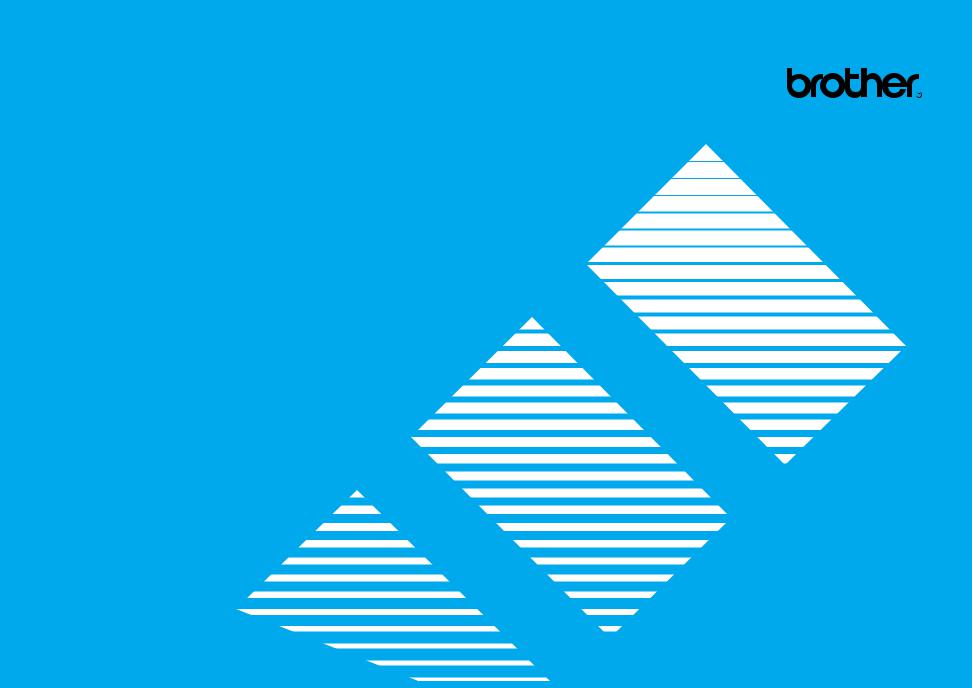
SEWING MACHINE
MACHINE À COUDRE
PQ1500S
OPERATION MANUAL
MANUEL D’UTILISATION
“IMPORTANT SAFETY INSTRUCTIONS”
“Read all instructions before using.”
When using a sewing machine, basic safety precautions should always be taken,
including the following:
DANGER – To reduce the risk of electric shock:
●The sewing machine should never be left unattended while plugged in. Always unplug the sewing machine from the electrical outlet immediately after using and before cleaning.
●Always unplug before changing the light bulb. Replace bulb with same type rated 120V 15 watts for 120V model or rated 240V 15 watts for 220-240V model.
WARNING – To reduce the risk of burns, fire, electric shock, or injury:
●Do not allow this sewing machine to be used as a toy. Close attention is necessary when the sewing machine is used by or near children.
●Use this sewing machine only for its intended use as described in this manual. Use only accessories recommended by the manufacturer as contained in this manual.
●Never operate this sewing machine if it has a damaged cord or plug, if it is not working properly, if it has been dropped or damaged, or dropped into water. Return the sewing machine to the nearest authorized dealer or service center for examination, repair, electrical or mechanical adjustment.
●Never operate the sewing machine with any air openings blocked. Keep ventilation openings of the sewing machine and foot control free from the accumulation of lint, dust, and loose cloth.
●Never drop or insert any object into any opening.
●Do not use outdoors.
●Do not operate where aerosol (spray) products are being used or where oxygen is being administered.
●To disconnect, turn the main switch to the symbol “O” position which represents off, then remove plug from outlet.
●Do not unplug by pulling on cord. To unplug, grasp the plug, not the cord.
●Keep fingers away from all moving parts. Special care is required around the sewing machine needle.
●Always use the proper needle plate. The wrong plate can cause the needle to break.
●Do not use bent needles.
●Do not pull or push fabric while stitching. It may deflect the needle causing it to break.
●Turn off power to the machine by flipping the ON/OFF switch to the symbol “O” before making any adjustments in the needle area, such as threading the needle, changing the needle, threading the bobbin or changing the presser foot etc.
●Always unplug the sewing machine from the electrical outlet when removing covers, lubricating, or when making any other user servicing adjustments mentioned in the instruction manual.
●This sewing machine is not intended for use by young children or infirm persons without supervision.
●Young children should be supervised to ensure that they do not play with this sewing machine.
CAUTION For U.S.A. only–
is intended to fit in a polarized outlet only one way.
If the plug does not fit fully in the outlet, reverse the plug.
If it still does not fit, contact a qualified electrician to install the proper outlet.
Do not modify the plug in any way. “SAVE THESE INSTRUCTIONS”
“This sewing machine is intended for household use.”
FOR USERS IN THE UK, EIRE, MALTA
AND CYPRUS ONLY
If your sewing machine is fitted with a three-pin non-rewireable BS plug then please read the following.
IMPORTANT
If the available socket outlet is not suitable for the plug supplied with this equipment, it should be cut off and an appropriate three-pin plug fitted. With alternative plugs an approved fuse must be fitted in the plug.
NOTE
The plug served from the main lead must be destroyed as a plug with bared flexible cords is hazardous if engaged in a live socket outlet. In the event of replacing the plug fuse, use a fuse approved by ASTA to BS 1362, i.e. carrying the  mark, rating as marked on plug.
mark, rating as marked on plug.
Always replace the fuse cover, never use plugs with the fuse cover omitted.
WARNING
DO NOT CONNECT EITHER WIRE TO THE EARTH TERMINAL WHICH IS MARKED WITH THE LETTER ‘E’, BY THE EARTH SYMBOL  OR COLOURED GREEN OR GREEN AND YELLOW.
OR COLOURED GREEN OR GREEN AND YELLOW.
The wires in this main lead are coloured in accordance with the following code:
Blue |
Neutral |
Brown |
Live |
As the colours of the wiring in the main lead of this appliance may not correspond with the coloured markings identifying the terminals in your plug, proceed as follows. The wire which is coloured blue must be connected to the terminal which is marked with the letter ‘N’ or coloured black or blue.
The wire which is coloured brown must be connected to the terminal which is marked with the letter ‘L’ or coloured red or brown.
CONGRATULATIONS ON CHOOSING
A BROTHER SEWING MACHINE
Your machine is one of the finest sewing machines available for home use.
To fully enjoy all the features incorporated into it, we suggest that you study this booklet.
PLEASE READ BEFORE USING YOUR SEWING MACHINE
For safe operation
●Be sure to watch the placement of your hands in relation to the needle while sewing. Do not touch moving parts such as the balance wheel, thread take-up or needle while the machine is operating.
●Remember to turn off the power switch and unplug the cord when:
●Operation is completed
●Replacing or removing the needle or any other parts
●A power failure occurs during use
●Maintaining the machine
●Leaving the machine unattended
●Do not place anything on the foot controller.
●Plug the machine directly into the wall outlet. Do not use extension cords.
For a longer service life
●When storing your sewing machine, avoid direct sunlight and high humidity locations. Do not store the sewing machine beside a space heater, iron, or other hot objects.
●Use only neutral soaps or detergents to clean the case. Benzene, thinner, and scouring powders can damage the case and machine, and should never be used.
●Do not drop or hit the machine.
●Always consult the operation manual when replacing any accessories, including: the presser feet, needle or other parts to assure correct installation.
For repair or adjustment
In the event that a malfunction occurs or adjustment is required, first follow the troubleshooting table in the back of the operation manual to inspect and adjust the machine yourself. If the problem persists, please consult your nearest authorized Brother service center.
To find out the name and phone number for your authorised Brother service center visit www.brother.com and use our convenient dealer locator.

CONTENTS
Accessories ....................................................................... |
1 |
Machine Features .............................................................. |
2 |
Before You Begin .............................................................. |
3 |
Power Cord and Foot Controller ............................... |
3 |
Power Switch ............................................................ |
3 |
Thread Tension Dial.................................................. |
3 |
Hand Wheel .............................................................. |
3 |
Stitch Length Regulator ............................................ |
3 |
Reverse Stitch Lever................................................. |
3 |
Presser Foot Lift Lever.............................................. |
4 |
Knee Lift .................................................................... |
4 |
Presser Foot Pressure Adjustment Dial .................... |
4 |
Fabric Extension Table ............................................. |
4 |
Thread Cutter Button ................................................ |
5 |
Needle Stop Position Button ..................................... |
5 |
Light Switch............................................................... |
5 |
Feed Dog Adjustment Knob ...................................... |
5 |
Changing Needles and Light Bulb ................................... |
6 |
Changing the Needle ................................................ |
6 |
Changing the Feed Pin ............................................. |
6 |
Changing Light Bulbs ................................................ |
6 |
Threading ........................................................................... |
7 |
Bobbin Winding ......................................................... |
7 |
Bobbin Insertion ........................................................ |
9 |
Upper Threading ..................................................... |
10 |
Using the Automatic Needle Threader .................... |
10 |
Stitch Samples and Needle Chart .................................. |
12 |
Stitch Samples ........................................................ |
12 |
Thread Tension ....................................................... |
12 |
Changing Presser Feet ................................................... |
13 |
Changing Presser Feet (Zipper Foot) ..................... |
13 |
Presser Feet ........................................................... |
13 |
Basic Sewing ................................................................... |
14 |
Basic Sewing .......................................................... |
14 |
Pin Feeding (for hard-to-handle fabrics) ................. |
14 |
Pin Feeding Mechanism ......................................... |
14 |
Rolled Hem Foot ..................................................... |
15 |
Zipper Foot .............................................................. |
16 |
Invisible Zipper Foot................................................ |
17 |
1/4” Foot .................................................................. |
17 |
Quilting Foot ............................................................ |
18 |
Walking Foot ........................................................... |
18 |
Fabric Separator (for joining lining to fabric) ........... |
19 |
Seam Guide ............................................................ |
19 |
Caring for Your Machine ................................................ |
20 |
Cleaning the Machine ............................................. |
20 |
Lubrication Points ................................................... |
20 |
Trouble Shooting ............................................................ |
21 |
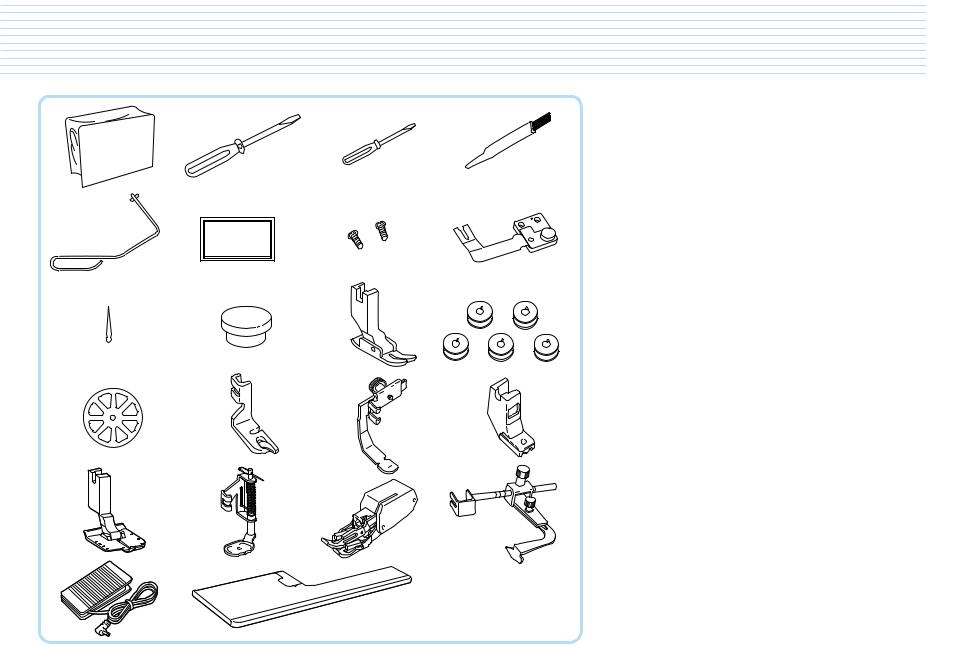
Accessories
1 |
2 |
3 |
4 |
5 |
6 |
7 |
8 |
9 |
10 |
11 |
12 |
13 |
14 |
15 |
16 |
17 |
18 |
19 |
20 |
21 |
22 |
No. |
Part Name |
|
Part Code |
1 |
Cover |
|
XA0917-052 |
2 |
Medium Screwdriver |
125877-001 |
|
3 |
Small Screwdriver |
|
125878-001 |
4 |
Cleaning Brush |
|
XA4527-001 |
|
|
|
|
5 |
Knee Lift |
|
XA0830-051 |
|
|
|
|
6 |
Needles and Case |
1 Size 9 |
|
|
(ORGAN HLX5) |
2 Size 11 |
|
|
|
1 Size 14 |
X80805-001 |
|
|
1 Size 16 |
|
|
1 Ballpoint Needle |
|
|
|
|
|
|
7 |
Lining Plate Screw (2) |
062670-812 |
|
8 |
Fabric Separator |
|
184720-001 |
9 |
Feed Pin |
|
138483-001 |
10 |
Feed Pin Changer |
|
XC1407-051 |
|
|
|
|
11 |
General Purpose Foot |
XA1425-001 |
|
|
|
|
|
12 |
Bobbin (5) |
|
SA159 |
13 |
Spool Cap |
|
XA2111-000 |
14 |
Rolled Hem Foot |
|
X57138-001 |
15 |
Zipper Foot |
|
112797-001 |
16 |
Invisible Zipper Foot |
148475-001 |
|
17 |
1/4” Foot |
|
XA7258-001 |
18 |
Quilting Foot |
|
XA7255-201 |
19 |
Walking Foot |
|
XA7253-001 |
20 |
Seam Guide |
|
XA7256-001 |
21 |
Foot Controller |
|
XC1220-051 |
22 |
Fabric Extension Table |
XC1387-051 |
|
Note
Foot controller: Model P
This foot controller is used for sewing machine model PQ1500S.
1
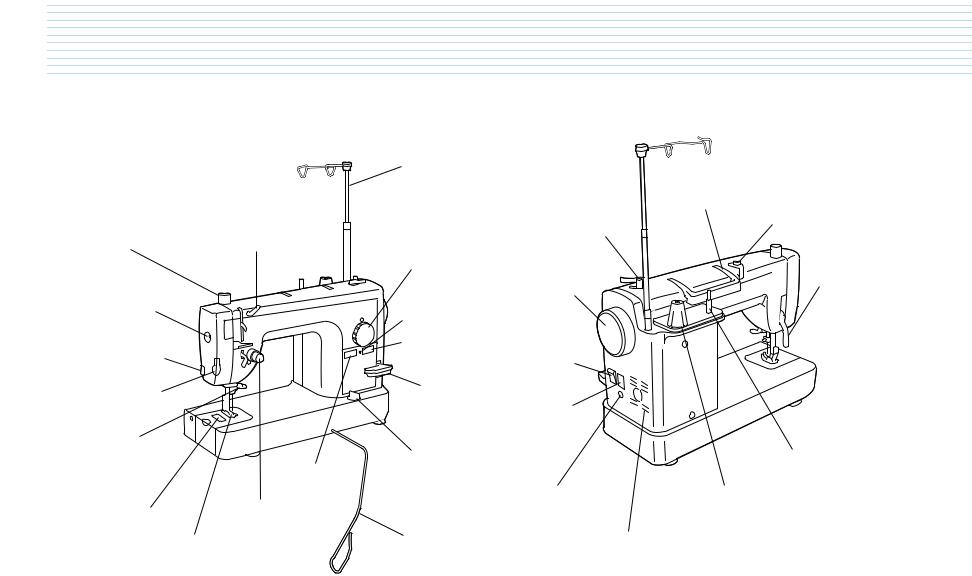
Machine Features
Presser Foot Pressure |
Three Holed |
|
Adjustment Dial (Page 4) |
Thread Guide (Page 10) |
|
Light Switch |
|
|
(Page 5) |
|
|
Thread Trimmer |
|
|
Sewing Area |
|
|
Light (Page 6) |
|
|
Automatic Needle |
|
|
Threader (Page 10 and 11) |
|
|
|
Thread Cutter |
|
|
Button (Page 5) |
|
Quick Bobbin |
Thread Tension Dial |
|
Thread Device (Page 9) |
||
(Page 3 and 12) |
||
|
Feed Dogs (Page 5 and 14)
Thread Guide Bar (Page 7)
Bobbin Winder
Stitch Length (Page 7)
Regulator (Page 3)
Hand Wheel (Page 3)
Indicator Lamp
Needle Stop Position
Button (Page 5) Power Switch
(Page 3)
Reverse Stitch
Lever (Page 3)
Power Socket (Page 3)
Feed Dog Adjustment
Knob (Page 5)
Foot Controller Jack (Page 3)
Knee Lift |
Air Vents |
(Page 4) |
|
Handle |
Thread Guide for |
|
Bobbin Winding (Page 7) |
Presser Foot
Lift Lever (Page 4)
Spool Pin (Page 7)
Spool Cushion (Page 7)
2
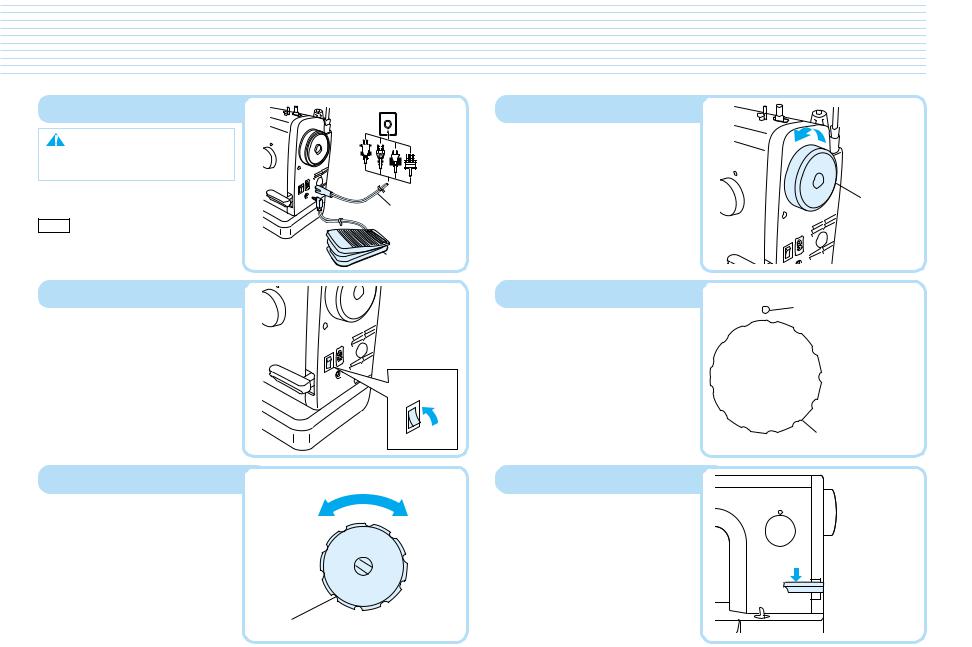
Before You Begin (1)
Power Cord and Foot Controller
Note
Please use common household current.
●Plug in cord.
●Plug foot controller into machine.
Note
Foot controller: Model P
This foot controller is used for sewing machine model PQ1500S.
Power Switch
●Flip power switch to “I” position to turn on.
●To switch power off, flip switch to “O” position.
Power Cord |
Foot Controller
Power Switch
I
O
Hand Wheel
●Position needle using hand wheel.
Always turn hand wheel towards you.
Stitch Length Regulator
●Adjust desired stitch length using stitch regulator dial.
Thread Tension Dial
●When tighter thread tension is desired, turn the tension dial to the right. Upper and bobbin threads will meet on right side of the fabric.
●When looser thread tension is desired, turn tension dial to the left. Upper and lower threads will then meet on wrong side of fabric.
Upper Thread Tension
Loosen |
Tighten |
Tension Block
Reverse Stitch Lever
●Sewing in reverse is possible when the reverse stitch lever is in the lowered position.
Make sure to push the lever all the way down when reverse sewing is desired.
When the feed adjustment dial is set between 5-7mm, the reverse stitch length is always 5 mm.
Hand Wheel
Stitch Length
Reference Mark
1
7 |
|
2 |
Lower number |
|
|
||
|
|
|
|
|
|
|
= shorter stitches |
6 |
|
3 |
Higher number |
|
= longer stitches |
||
|
5 |
|
|
|
4 |
|
|
|
|
|
Stitch Length Regulator
Reverse Stitch
 Lever
Lever
3

Presser Foot Lift Lever
Lowering the presser foot lift lever lowers the sewing foot down onto the fabric and engages the thread tension function.
When working with heavy fabrics or other fabrics that don’t slide easily under the foot, raise the presser foot lever to position the fabric.
Knee Lift
Using the convenient knee lift to lift and lower the presser foot easily, leaving both your hands free.
Setting up the knee lift.
Push the knee lift bar all the way into the socket.
When knee lift is not in use, it can rest at the bottom of the fabric extension table.
Presser Foot
Lift Lever
Knee Lift
Fabric Extension Table
Knee Lift
Presser Foot Pressure
Adjustment Dial
Turning the pressure adjustment dial raises and lowers the pressure indicator needle as the amount of pressure on the presser foot changes.
See also: “Feed Dog Adjustment Knob” on page 5.
See “Thread Tension” on page 12.
Presser Foot Pressure Adjustment Dial
Pressure Indicator
Needle
Fabric Extension Table
Lower table feet and attach fabric extension table as shown in the below diagram.
2
Hole |
|
|
Guide pin |
|
|
|
3 |
Stopper |
2 |
|
3 |
|
|
|
1 |
|
|
Table legs |
Hook |
|
4
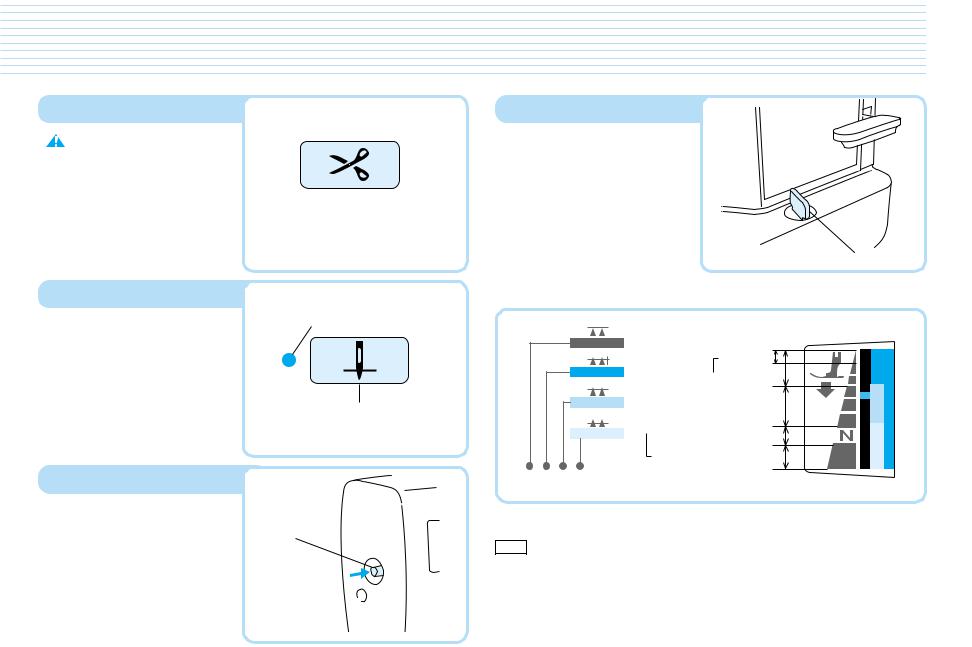
Before You Begin (2)
Thread Cutter Button
Note |
|
|
|
When the machine stops due to |
|
|
|
jammed threads and so forth, do not |
|
|
|
step on the foot controller, turning the |
|
|
|
|
|
||
power off and moving the needle with |
|
|
|
the hand wheel, check the situation. |
|
|
|
Thread Cutter Button |
|||
Otherwise broken needles could result. |
|||
|
|
||
|
|
|
|
● The thread cutter trims upper and |
Press with the presser lever down. |
||
|
|||
bobbin threads at the end of seams.
Needle Stop Position Button
●When indicator lamp is lit up, the machine will stop sewing with the needle lowered through the fabric.
●When indicator lamp is off, the needle position when sewing stops, will be random.
●If the safety mechanism is activated, for example if the thread becomes tangled, the red lamp flashes.
Light Switch
●Push light switch to turn the light over the sewing area on and off.
Indicator Lamp
Needle Stop Position Button
Light Switch
Feed Dog Adjustment Knob
● Height of feed dogs can be adjusted to coincide with fabric weights.
Feed Dog Adjustment Knob
Foot Pressure and Feed Dog Position
 (Feed Dogs Down)
(Feed Dogs Down)
Velvet 
 (Pin Feeding)
(Pin Feeding) 
 Lightweight Fabrics
Lightweight Fabrics 
 Middleweight Fabrics
Middleweight Fabrics 
Heavyweight Fabrics 
Select one of four feed dog positions according to your needs.
Note
If a setting other than  is selected, the pin feed mechanism will not operate.
is selected, the pin feed mechanism will not operate.
5
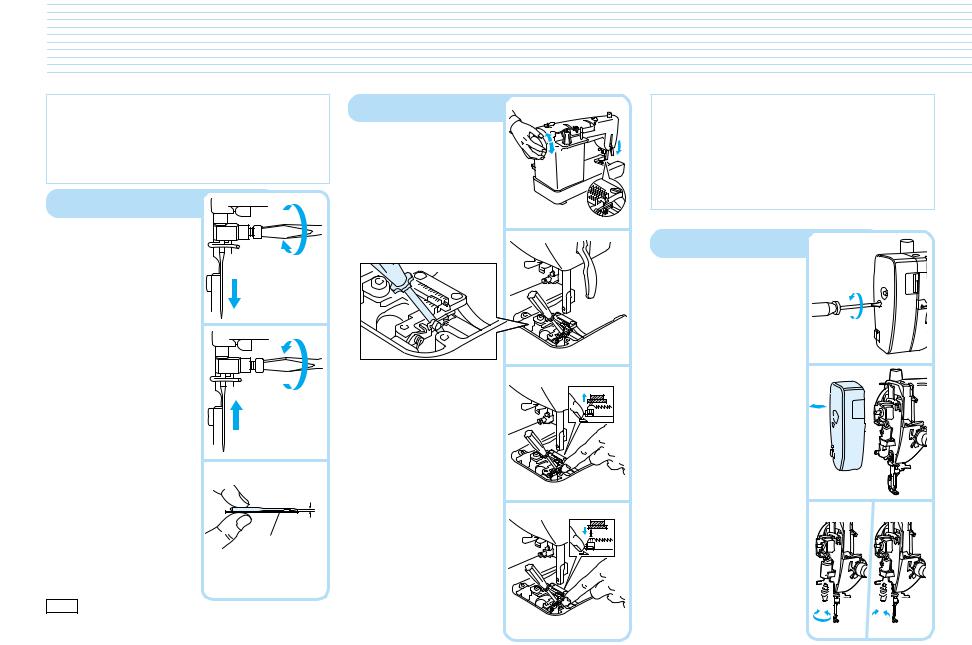
Changing Needles and Light Bulb
 Note
Note
Please make sure power is off before carrying out the following operations. There is a chance of injury if the machine accidentally starts running during this operation.
Changing the Needle
1Turn the sewing machine off. Raise needle to highest position using hand wheel, and lower presser foot.
2Loosen screw with screwdriver, and remove needle.
3Hold the needle with the flat side to the right, and insert the needle as far as it will go. Make sure needle is screwed in tightly.
If the needle is not adequately inserted or the screw is loose, this may break the needle or cause a breakdown and the needle threader will not work.
Check needles on a flat surface to make sure they are not bent.
Note
Screwdriver
The needle should lay
parallel to a surface.
Flat surface
Lay needle on a flat surface
(such as the needle plate or a plate
of glass).
HLX5 needles should be used; however, Schmetz 130/ 705H may also be used under normal circumstances.
Changing the Feed Pin
1 Set the feed dogs to “velvet” position. (See page 5.)
2 Remove needle, presser foot and needle plate.
3Lower presser foot and turn hand wheel until feed
pin is in its highest position.
4Insert small screwdriver (included) as shown in diagram.
5While holding spring with fingertip, lower the feed pin changer onto the needle to pick it up.
6Attach new feed pin to feed pin changer, lower and attach while holding
spring with fingertip. 7 Remove screwdriver.
8Re-attach needle plate, needle and presser foot.
 Note
Note
Please make sure power is off before carrying out the following operation. The glass plate over the light bulb will be hot immediately after using the machine, therefore it is advisable to wait until the light bulb has had a chance to cool down before changing bulbs.
Changing Light Bulbs
1 Turn off power.
2Remove screw from head.
3 Remove bulb housing.
4Unscrew bulb and remove.
5 Screw in new bulb. Sewing Light:
See page 20.
6Re-attach bulb housing and tighten screw.
Screwdriver
230V 120V
 Light
Light  Light
Light
Bulb  Bulb
Bulb
6
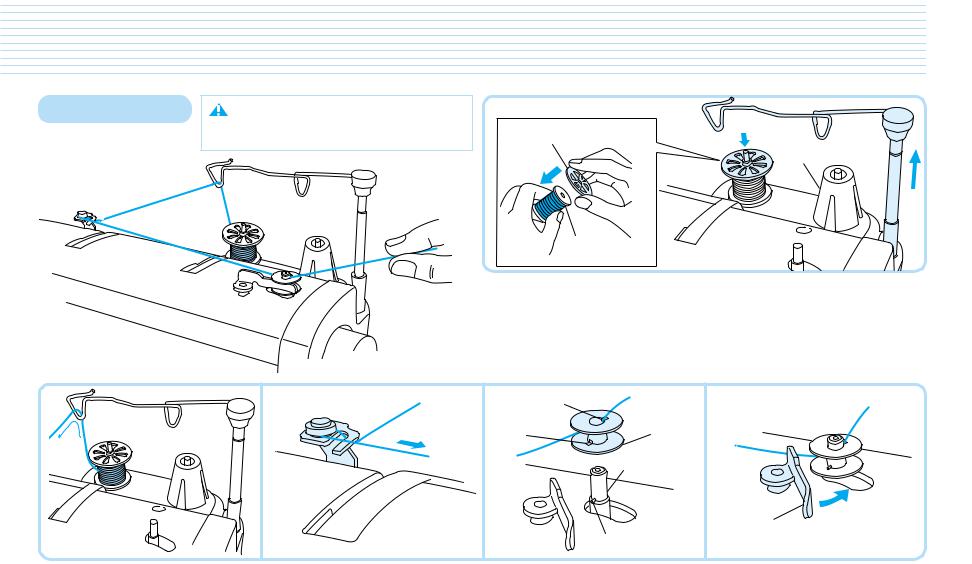
Threading (1)
Bobbin Winding |
Note |
]1 |
|
|
Do not move bobbin winding clutch while machine |
|
|
|
is running. |
Spool Cap |
2 ]2 |
|
|
|
Spool Cushion |
|
3 |
1 |
|
4 |
|
|
1 |
|
|
|
|
2
Spool of Thread
1 Raise the thread guide bar all the way.
2 Mount a spool thread on the spool pin.
1 Use spool cap when using parallel-wound thread.2 Use spool cushion when using cross-wound thread.
5 - 0: See the following illustrations.
Thread Notch 1 |
|
Thread Notch 2 |
Bobbin |
3 |
Bobbin Winder |
|
Shaft |
|
|
Guide Pin |
3 Pass the thread through the triangu- |
4 Pass thread through bobbin winding |
5 Run thread through top thread notch |
lar hole. |
thread guide as shown in drawing. |
1, and align bottom thread notch 2 of |
|
|
the bobbin with guide pin on bobbin |
|
|
winder shaft. |
Bobbin Winding Clutch
6Press bobbin winding clutch up against empty bobbin. If the bobbin stop does not slide easily between the top and bottom of the bobbin, check that the bobbin is seated prop-
erly with the guide pin (5) inserted 7 into the lower notch.

|
|
|
|
|
|
|
|
|
|
|
|
|
|
|
|
|
|
|
|
|
|
|
|
|
|
|
|
|
|
|
|
|
|
|
|
|
|
|
|
|
|
|
|
|
|
|
|
|
|
|
] Place the thread end so that it does |
|
Bobbin Winding Clutch |
|
|
|
|
||
|
|
|
|
|
|
not protrude from the bobbin. |
|
|
|
|
7 While holding the end of the thread, step on |
8 Stop winding process when bobbin is |
9 Manually move bobbin winding clutch 0 Cut thread and remove bobbin. |
|
|
the foot controller for a few seconds. Once |
full. Take the foot off foot controller. |
back to original position. |
|
|
enough thread has wound itself around the |
|
|
|
|
bobbin to hold itself in place, release the |
|
|
|
|
foot controller and trim the excess thread. |
|
|
|
|
Continue to wind the bobbin while pressing |
|
|
|
|
down on the foot controller. |
|
|
|
8

Bobbin Insertion |
CAUTION – Moving parts – |
|
||
|
|
To reduce risk of injury, switch power off before servicing. Open covers. |
|
|
|
|
Latch Spring |
Quick Bobbin |
|
|
Needle Plate |
|||
1 |
Thread Device |
|||
|
|
|||
|
|
|
1 |
|
2 |
|
Thread Notch |
3 |
|
|
|
|
||
|
|
|
2 |
|
|
Bobbin Door |
Bobbin should be |
|
|
|
positioned so it |
|
||
|
|
|
||
|
|
winds to the left. |
|
|
1Lift needle plate and open bobbin door.
2
1


5Lower slide plate and close bobbin door, following numbers 1 2 above in order.
2 Put bobbin into the bobbin case.
Run thread through thread notch and under latch spring, so that a length of thread is exposed.
Always use the bobbin case that was supplied with this machine. A secondary bobbin case can be ordered from your dealer.
3Pull the latch lever of the bobbin case out and push the bobbin case into the shuttle race and release the latch lever.
If the latch lever is not set securely on the hook, it may fly off during sewing and cause lower thread breakage.
Rotate the hand wheel one full rotation towards you to check that the bobbin case is set securely.
When the fabric extension table is set in place
Open the bobbin thread setting cover beforehand, then set the bobbin thread in place. (You can set the bobbin thread in place without removing the fabric extension table.)
Bobbin Thread Setting Cover
4Pass the thread through the quick bobbin thread device in the order 1 2, pull in the direction of the arrow 3, then cut the thread.
Quick Bobbin Thread Device
This device cuts the bobbin thread end to an appropriate length after the bobbin has been replaced and holds it at that length, so the operation of pulling out the thread can not be skipped.
9
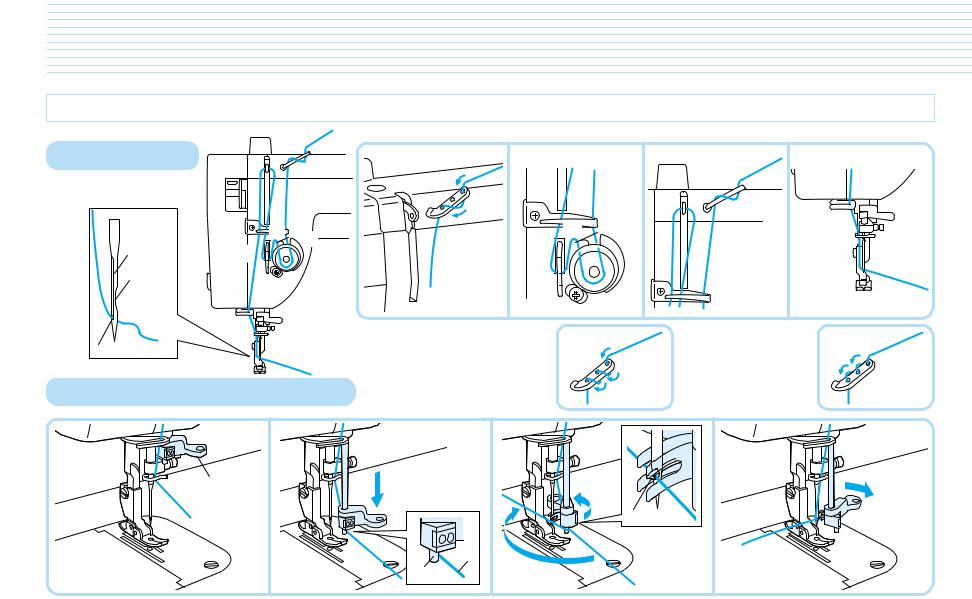
Threading (2)
 Note Please turn off the power before using automatic needle threader. Accidentally stepping on the foot controller during this operation could cause bodily injury or damage to the machine.
Note Please turn off the power before using automatic needle threader. Accidentally stepping on the foot controller during this operation could cause bodily injury or damage to the machine.
1
Upper Threading |
7 |
|
|
|
|
|
|
|
|
|
|
|
|
|
|
|
|
|
|
1 |
|
|
|
|
|
|
|
|
6 |
7 |
|
|
|
|
|
|
|
|
|
|
8 |
6 |
|
|
|
2 |
9 |
|
|
2 |
|
4 |
|
||
|
4 |
|
3 |
0 |
|||
Long |
|
|
3 |
|
|
||
5 |
|
|
|
|
|
|
|
Groove |
|
|
|
|
|
|
|
|
|
|
|
|
8 |
A |
|
Depression |
|
|
|
5 |
|
||
|
|
|
|
|
|
||
|
|
|
|
|
|
|
|
Thread |
9 |
|
|
Make sure thread take-up lever is in |
|
|
If the thread is still |
0 |
|
|
|
|
|||
|
|
|
highest position and presser foot is up. |
|
|
tangles or breaks, run |
|
Needle Hole |
|
A |
|
|
|
||
|
|
|
|
|
the thread through the |
||
|
|
|
|
|
|
|
|
|
|
|
|
When using polyester thread or thread |
|
|
holes backwards as |
Using the Automatic Needle Threader |
that tangles or breaks, run the thread |
|
|
shown in diagram. |
|||
|
|
|
|
through all three holes of the thread guide. |
|
|
|
Automatic |
|
1 |
Needle |
|
|
|
|
|
Threader |
|
Hook |
|
|
Pull the thread to |
Thread |
2 |
the left and check |
that it is caught on |
||
Pin |
|
the hook. |
|
|
1 Rotate hand wheel towards you until needle is in the highest position, and lower presser foot.
10 2 Take thread in your left hand, and gently pull it forward.
3 Lower automatic needle threader.
Pull thread along the right side of the pin.
Do not force the needle threader lower than the eye of the needle. Be sure that the needle is in the highest position.
4Turn the needle threader lever all the way in the direction of 1 and when the hook extends from the needle hole, pull the thread in the direction of 2 to catch it on the hook.
5While holding the thread gently, return the needle threader lever to the right. As you do this the hook that has caught the thread will move as well, pulling a loop of thread through the eye of the needle.

Needle (HLX5) |
Thread |
|
|
#9 |
#20 #30 #50 #60 |
|
|
#11 |
#20 #30 |
|
|
#14 |
#20 #30 |
|
|
#16 |
#20 |
|
|
6 Pull thread loop to the right.
●The automatic needle threader cannot be used with the threadneedle combinations illustrated in the chart to the left. Transparent nylon thread can be used regardless of the chart, providing the needle used is a #14 or #16.
11
